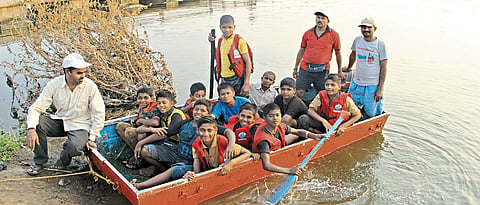

Spreading the message of river conservation, Jal Dindi reached Pandharpur from Alandi on November 4, completing its annual journey for the 16th time
For the 16th year in a row, the Jal Dindi successfully completed its journey from Alandi to Pandharpur on November 4. The participants of the dindi travelled for seven days on the Bhima River in boats.
“The purpose of the dindi is to take affirmative action for environment, health and spirituality,” said founder of the Jal Dindi Dr Vishwas Yevale, a gynaecologist based in Pune. Though Dr Yevale, 58, has seen the condition of the river deteriorating each year because of pollution and the sand mafia, he still has hope. “There is hope because the river has the capacity to clean itself after the monsoon, provided we don’t dirty it,” he added.
The Jal Dindi is akin to the Wari that travels by foot from Alandi to Pandharpur, except this dindi travels by water on the Indrayani and Bhima rivers. One boat in the Jal Dindi, organised by Jal Dindi Pratishthan, carried Saint Dnyaneshwar’s paduka. The men and women travelled about 450 km in three motorboats and a two-seater kayak. Some portions of the journey, where the waters were too treacherous or time too short, were covered in trucks and cars. Of almost 50 bunds on the entire river stretch, the boats had to be hauled over at least three every day.
The dindi passed through over 20 villages in two districts of Pune and Solapur spreading the message of river conservation. It was welcomed joyously by villagers wherever it halted. They hosted the participants, aka Jal Warkaris, for most lunches and dinners.
Like the monsoon after each summer, the Jal Warkaris arrive for the dindi each year. They are closely tied to the functioning and to each other. The Jal Dindi has now become an unending tradition since its inception in 2002.
Among the 70 odd participants this year was a group of 22 school children from the Shriram Warkari Shikshan Sanstha, Girawali. Their bhajan, abhang and hari paath throughout the journey brought the halts and evenings to life. The other participants were from different walks of life: farmers, housewives, rowing coaches, a retired teacher, businessmen, and maharaj of the warkari community.
Raju Bhalekar, rowing coach at COEP, Pune, is one of the founder members of the Jal Dindi. He has seen the river which flows by COEP get dirty with each passing year, so he takes the chance during the dindi to tell people about the problems of the river. “I have a skin infection because I work in the polluted water of the river. People along the banks of the Bhima have also told me of skin problems when they go fishing. I don’t want others to face these issues, so I talk to people during the dindi and urge them to work together to take care of the river,” he said.
Santosh Kabra, 52, and her sister-in-law Shashikala Tapadia came for the religious and spiritual aspects of the Jal Dindi for the first time this year, and were fascinated by the work that the Jal Dindi Pratishthan has done in the villages — tree plantation, awareness about pollution, and so on. “I thoroughly enjoyed the completely free environment during the dindi: clean air, exciting river travel, and no tension,” said Santosh. “Another aspect I loved was that the people became like a family.”
Each year, the dindi gives the participants a chance to observe the river up close. The Jal Warkaris observed patches of serene beauty with birds like ibis, different kinds of herons, terns, ducks, colourful dragonflies, and fish leaping out of the water. They also saw heaps of sand piled by denuded banks as filthy water flowed by. Dead fish floated on the surface in some stretches, while fishing nets crowded the river in others.
Like Dr Yevale said, the participants got a chance to chat with the river and immerse themselves in its folds during the eight-day journey. He hopes that the sojourn inspires at least 10 people to take up the cause of the river.
“The river gave me 1000 crore times more than what I can give her. I can at the very least make a path and educate people who will listen,” he said.
